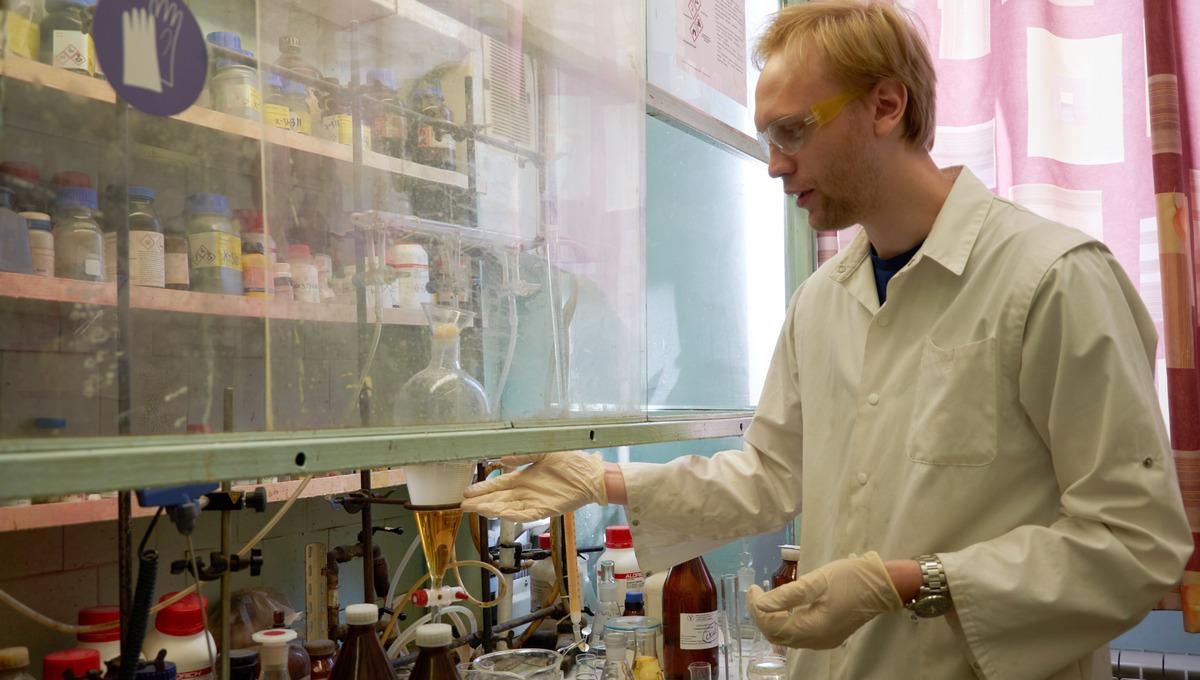Reviewed by Alex SmithJun 17 2022
UrFU chemists have developed a sensor that can determine the pH level of human saliva. This is a fluorophore with a strong and steady emission that detects even minor pH changes in biological fluids (tenths). Micro doses of the chemical are used in the analysis, as well as a spectrometer in which the substance is irradiated with a specific light (its lifetime is tens of thousands of hours). In 5–7 seconds, the pH data emerges.
 Timofey Moseev has been engaged in research work since 2015. Image Credit: Regina Pidgaetskaya.
Timofey Moseev has been engaged in research work since 2015. Image Credit: Regina Pidgaetskaya.
The initial findings of combined tests of saliva samples and the sensor, undertaken by research groups from the Institute of Chemical Engineering’s Department of Organic and Biomolecular Chemistry and Department of Analytical Chemistry, are published in the renowned Dyes and Pigments journal.
Modern fluorometric pH sensors are based on small organic molecules. Typically, they are very sensitive and are able to detect the desired analytic in very low concentrations, up to nanoconcentrations. Our sensor is based on a new compound. We introduced a fluorinated fragment, and this allowed us to get the photophysical and electrochemical properties we needed.
Timofey Moseev, Engineer-Researcher, Department of Organic and Biomolecular Chemistry, Ural Federal University
Saliva pH analysis is a simple and non-invasive way to diagnose a condition. Early detection of disorders, particularly gastrointestinal illnesses such as gastritis, stomach ulcers, and duodenitis, is possible with its assistance. The pH level has an impact on the teeth as well: even a small rise in saliva acidity can induce tooth decay and other issues.
The new compound is the outcome of years of collaboration between the Institute of Chemical Engineering’s departments of organic and biomolecular chemistry and analytical chemistry. Moseev has been working on research on this issue since his second year of bachelor’s studies in 2015 as a member of the research group, according to Mikhail Varaksin, head of the Institute of Chemical Engineering at Ural Federal University.
The sensor is reusable, non-toxic, and safe for the environment. Chemists created it using an atom-efficient synthesis process that required no catalysts (nickel, copper, or palladium) or extra reagents. In addition, the sensor is soluble in water.
In the classical method of synthesis, two molecules require active fragments that interact with each other, and thus a new compound is obtained. But the principles of ‘green chemistry’ require that the reactions take place without by-products, in non-toxic solvents (water), and with minimal use of active fragments. If these active fragments are removed, the simplest carbon-hydrogen bond in organic chemistry is left.
Timofey Moseev, Engineer-Researcher, Department of Organic and Biomolecular Chemistry, Ural Federal University
“The reaction takes place between the two. In this way an atomic economy is obtained. Since the reaction takes place between C-H/C-H, the byproducts are more likely to be water or a similar compound. The synthesis results in fewer by-products and noxious products,” Timofey Moseyev outlines the technique in detail.
Ural chemists have developed novel chemosensors that may be used to test the water (acidity, metals, or toxins) as well as fluorescent probes to reveal intracellular activities. The substance stains a specific section of the cell and accumulates in a specific area of the cell. This line of application, however, has yet to be investigated.
In general, the organic fluorophores developed by UrFU chemists are attractive materials for a variety of sectors, in addition to biological applications, due to their wide range of practical uses. Fluorophores, in particular, are utilized in molecular electronics. Solar cells’ “hearts” (working elements) are comparable to organic molecules. Computer and monitor OLED panels are another example. They are also based on an organic molecule having photophysical properties.
Journal Reference:
Moseev, T. D., et al. (2022) Fluoroaromatic 2H-imidazole-based push-pull fluorophores: Synthesis, theoretical studies, and application opportunities as probes for sensing the pH in saliva. Dyes and Pigments. doi.org/10.1016/j.dyepig.2022.110251.